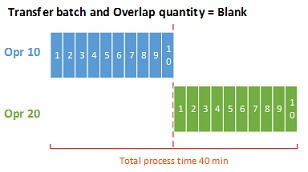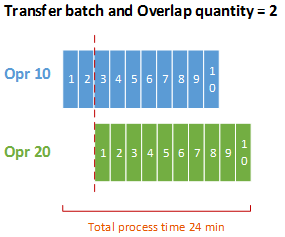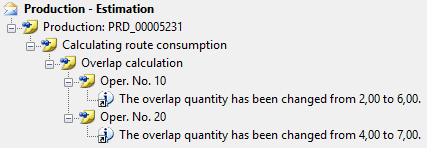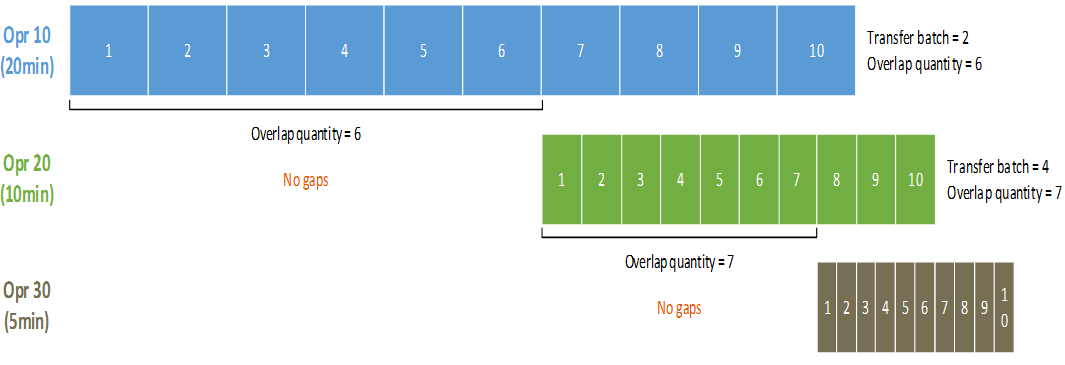Working with Overlap in Microsoft Dynamics AX
Conducting Dynamics AX Manufacturing training for a class in Malaysia, it became clear that the current documentation on Overlap in Dynamics AX was not telling the full story.
Therefore, I decided to write this blog.
So, what is Transfer batch and Overlap quantity?
In Dynamics AX ‘Transfer batch’ is the field used to control an overlapped schedule. Apics define ‘Overlapped schedule’ as “A manufacturing schedule that overlaps successive operations. Overlapping occurs when the completed portion of an order at one work center is processed at one or more succeeding work centers before the pieces left behind are finished at the preceding work centers.”
Overlapped schedule is also known as lap phasing, operation overlapping, telescoping or send ahead.
‘Overlap quantity’ is a calculated field on the production order – ensuring that we avoid gaps in the schedule, when the successor operation to the operation with a Transfer batch value, has a shorter process time.
The ‘Overlap quantity’ determines the first transfer batch size for the operation; the following transfers to the next operation will use the ‘Transfer batch’ value.
Overlap quantity example
Say you have a production order for 10 pcs and it has two operations 10 and 20, each operation taking 2 minutes per pcs:
Without overlap:
Normally operation 20 will start when the entire quantity (10 pcs) has been processed on operation 10

With overlap:
When you have specified something in ‘Transfer batch’ field, let us say 2 pcs, it means the next operation (in our case 20) can already start when only 2 pcs has been processed on the operation 10. The value from ‘Transfer batch’ is by default copied to the ‘Overlap quantity’, on the production order.

Why does the Overlap quantity sometimes change when I estimate a production order?
The ‘Overlap quantity’ parameter on the production order route is calculated by the system. This is done during the estimation (or scheduling) of the production order, to prevent gaps in situations where a later operation have a shorter process time than the current operation. The fact that the successor would be waiting for the delivery from the predecessor would be causing a gap.
So, the calculation of an optimal ‘Overlap quantity’ is done based on the ‘Transfer batch’ and the operation process durations on the route.
Overlap example with gaps (two operations):
Say you have a production order for 10 pcs and it has two operations 10 and 20, this time the first operation takes more time than the second does:
Opr 10: 20 min per pcs
Opr 20: 10 min per pcs
Again, we have a Production order for 10 pcs and Transfer batch quantity set to 2 pcs
Without any change during Estimation the jobs on the route would have a gapped schedule and look like this:
However, as the first operation in total will take 200 min to complete and the second will take 100 min you will get the following information when estimating:
With the change from 2 to 6 we ensure that there are no gaps between the jobs in the second operation.
Overlap example with gaps (three operations):
Now let us spice it up a bit and add another operation – Opr. 30 with a run time of 5 min per pcs. We will also set a ‘Transfer batch’ = 4 on operation 20
In this case, you get the following information during estimation:
Now the schedule will look like this:
Therefore, by updating the ‘Overlap quantity’ on the production order during the Estimation Dynamics AX ensures that production on the following operation can happen without any gaps – avoiding a gapped schedule.
Christian Rytt, Senior Program Manager at Microsoft Development Center Copenhagen





